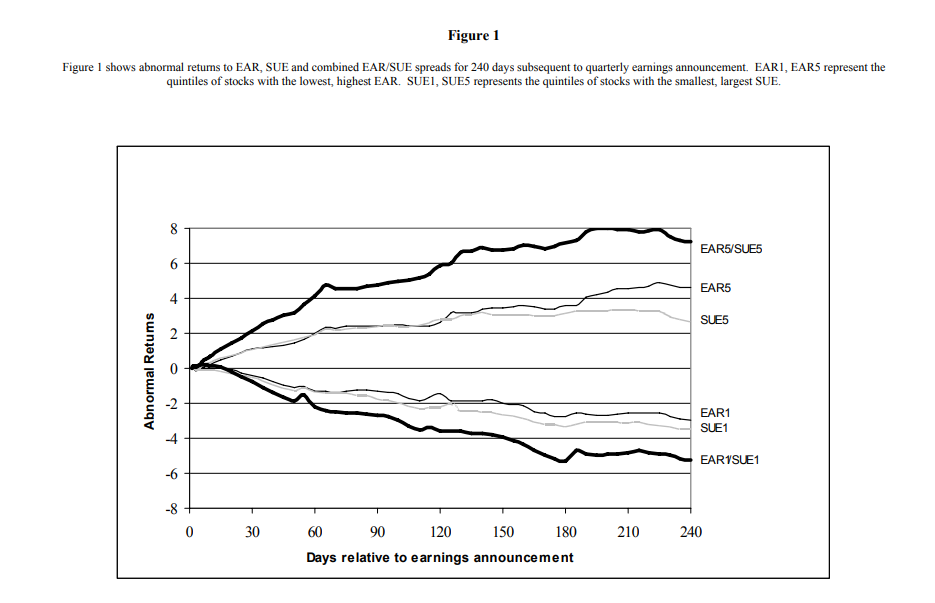We’ve already analyzed tens of thousands of financial research papers and identified more than 700 attractive trading systems together with hundreds of related academic papers.
Browse Strategies- Unlocked Screener & 300+ Advanced Charts
- 700+ uncommon trading strategy ideas
- New strategies on a bi-weekly basis
- 2000+ links to academic research papers
- 500+ out-of-sample backtests
- Design multi-factor multi-asset portfolios
Upgrade subscription
Post-earnings announcement drift or PEAD is the tendency for a stock’s cumulative abnormal returns to drift for several weeks (even several months) following the positive earnings announcement. It is an academically well-documented anomaly first discovered by Ball and Brown in 1968 (we present links to several related academic research papers). Since then, it has been studied and confirmed by countless academics in many international markets. There are a number of ways to define an earnings surprise (or ways to filter stocks with the positive response to earnings) – earnings higher than analysts estimates, earnings higher than some average earnings or stock’s price appreciation during earnings announcement period higher than expected. Each factor shows a strong prediction ability for the stock’s future returns, and it is good to use some combination of factors to enhance the PEAD effect.
We present one such strategy from the source paper related to this anomaly. This strategy is presented in its long-short form, but most of the returns come from the long side, so it is not a problem to implement it as long-only. Research also shows that the main performance contributors are small-capitalization stocks; therefore, caution is recommended during the strategy’s implementation.
Fundamental reason
This phenomenon can be explained with several hypotheses. The most widely accepted explanation for this effect is investors’ under-reaction to earnings announcements. It is also widely believed that there is a strong connection between earnings momentum and price momentum.
Several studies also show earnings momentum could be explained by liquidity risk as the Post-Earnings Announcement Effect appears to be strong in small-cap stocks.
- Unlocked Screener & 300+ Advanced Charts
- 700+ uncommon trading strategy ideas
- New strategies on a bi-weekly basis
- 2000+ links to academic research papers
- 500+ out-of-sample backtests
- Design multi-factor multi-asset portfolios
Backtest period from source paper
1987-2004
Confidence in anomaly's validity
Strong
Indicative Performance
15%
Notes to Confidence in Anomaly's Validity
Notes to Indicative Performance
per annum, strategy’s performance calculated as annualized (geometrically) 60 days return (2.97%-(-0.58%)) for long-short portfolio from table 7.
Period of Rebalancing
Quarterly
Notes to Period of Rebalancing
Notes to Estimated Volatility
Number of Traded Instruments
1000
Notes to Number of Traded Instruments
more or less, it depends on investor’s need for diversification
Notes to Maximum drawdown
Complexity Evaluation
Complex strategy
Notes to Complexity Evaluation
Financial instruments
stocks
Simple trading strategy
The investment universe consists of all stocks from NYSE, AMEX, and NASDAQ except financial and utility firms and stocks with prices less than $5. Two factors are used: EAR (Earnings Announcement Return) and SUE (Standardized Unexpected Earnings). SUE is constructed by dividing the earnings surprise (calculated as actual earnings minus expected earnings; expected earnings are computed using a seasonal random walk model with drift) by the standard deviation of earnings surprises. EAR is the abnormal return for firms recorded over a three-day window centered on the last announcement date, in excess of the return of a portfolio of firms with similar risk exposures.
Stocks are sorted into quintiles based on the EAR and SUE. To avoid look-ahead bias, data from the previous quarter are used to sort stocks. Stocks are weighted equally in each quintile. The investor goes long stocks from the intersection of top SUE and EAR quintiles and goes short stocks from the intersection of the bottom SUE and EAR quintiles the second day after the actual earnings announcement and holds the portfolio one quarter (or 60 working days). The portfolio is rebalanced every quarter.
Edit: We use long-only implementation of PEAD strategy, as research papers shows that the most of the return of this effect comes from the long side …
Hedge for stocks during bear markets
Not known - Source and related research papers don’t offer insight into the correlation structure of PEAD strategy to equity market risk; therefore, we do not know if this strategy can be used as a hedge/diversification during the time of market crisis. PEAD strategy is usually built as a long-short equity strategy, but it can be split into two parts. The long leg of the strategy is surely strongly correlated to the equity market; however, the short only leg can be maybe used as a hedge during bad times. Rigorous backtest is, however, needed to determine return/risk characteristics and correlation.
Out-of-sample strategy's implementation/validation in QuantConnect's framework
(chart+statistics+code)










